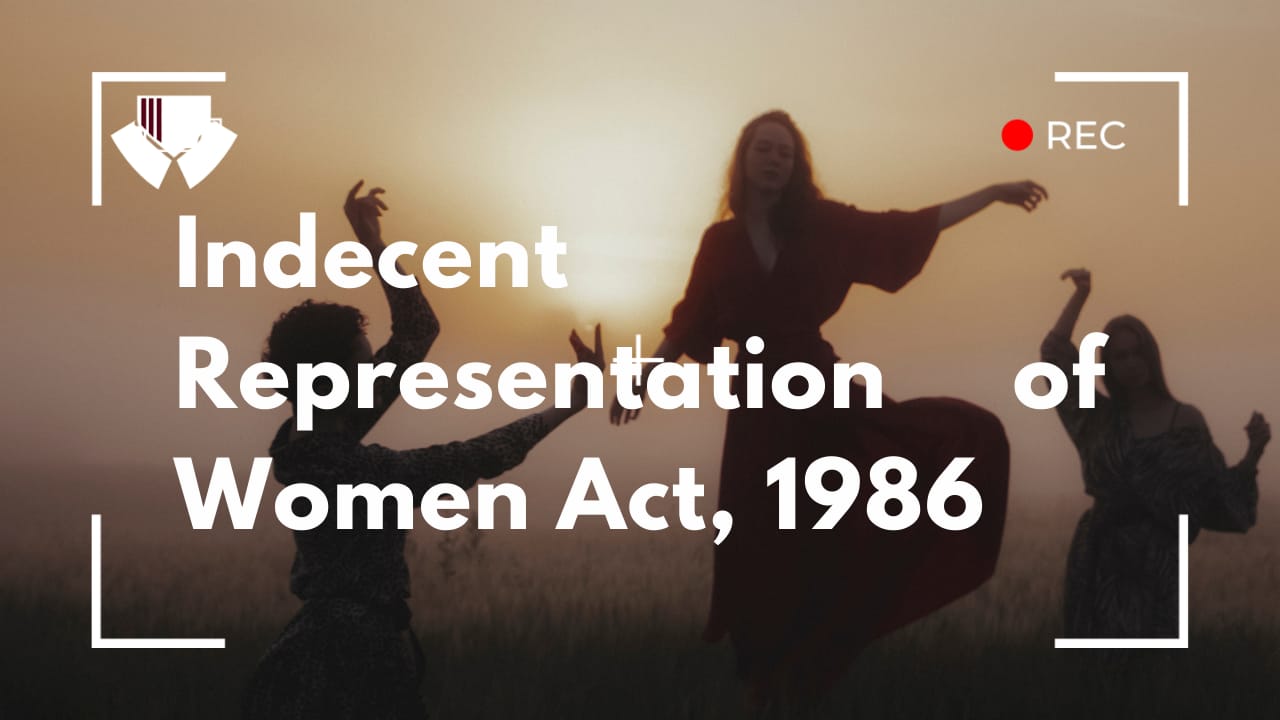This blog is written by Jyoti Shukla, a 2nd year B.S.C LL.B student from National Forensic Sciences University Gandhinagar, Gujarat.
Introduction
The Indian Penal Code’s Sections 292, 293, and 294 make it illegal to publish pornographic books, sing pornographic songs, or engage in pornographic behavior in or near public areas. These rules, it was discovered, were insufficient to address the problem of indecent portraiture of women, which mostly concentrated on nudity and sexually suggestive material.
A growing number of references to or depictions of women indecently have the effect of dehumanizing women while also being offensive to them. Even though there might not be a deliberate goal, these publications, ads, etc. have a corrupting or depraving effect. Therefore, in order to effectively prevent the indeterminate representation of women in advertisements, books, pamphlets, and other media, different legislation was required.
The term “indecent representation of women” refers to any depiction of a woman’s figure, form, or body in any way that could be interpreted as demeaning to, indecent, or demeaning to women, or as likely to degrade, corrupt, or harm public morality. This Act punishes such depictions. It declares that no one may publish, arrange to be published, publish, or take part in the publication or exhibition of any advertisement that features any kind of derogatory portrayal of women.
History of the Bill
A women’s movement that demanded legal action against the derogatory portrayal of women in the nation led to the introduction of the Rajya Sabha Bill against Women’s Indecent Representation in 1986. Margaret Alva introduced the bill in the Rajya Sabha, and it was enacted into law in October 1987.
The law was designed to control how women were portrayed in popular media, particularly print. It was put into place to make sure that advertisements, magazines, publications, and illustrations featuring women did not depict them in an offensive manner.
Object of the Act
In this nation, the laws regarding obscenity are enshrined in Sections 292 through 294 of the Indian Penal Code. Despite these restrictions, there is an increasing amount of indecent representation of women or references to women in publications, particularly in advertisements. This denigrates women while also being offensive to them. Even though there might not be a deliberate goal, these publications, ads, etc. have a corrupting or depraving effect. Therefore, in order to effectively prevent the indeterminate representation of women in advertisements, books, pamphlets, and other media, different legislation is required.
Any publication, note, sticker, packaging, or other document covered by the Act that is visible through the use of light, sound, smoke, or gas is considered an advertisement. In addition to any visible representation produced by any laser light, sound, smoke, gas, fiber, electronic optic, or other media, the National Commission for Women’s amendment would expand the definition of advertisement to include any sign, circle, sticker, poster, wrapper, or other document. It says that no one may create, market, hire, ship, distribute, or circulate any book, pamphlet, document, slide, video, writing, drawing, painting, image, representation, or figure that contains any lewd picture of a woman. The Commission has additionally suggested that the word “degrading” be included next to “indecent.”
The bill introduces two significant changes: first, it clarifies which advertisements, if passed, will be subject to its provisions; second, it specifies what will constitute delivery of goods that will trigger the amendment’s punitive provisions under the new regulatory framework. Print, digital, and electronic media were all included in the proposed regime’s specifications for content delivery.
Important Provisions
| Sl. No. | PROVISIONS | SUMMARY |
| 1. | PURPOSE | The act aims to o prohibit indecent representation of women through advertisements or in publications, writings, paintings, figures or in any other manner. |
| 2. | SECTION 2 DEFINITIONS | The Act defines indecent representation of women as the depiction in any manner of the figure of a woman, her form or body or any part thereof in such a way as to have the effect of being indecent, or derogatory to, or denigrating, women, or is likely to deprave, corrupt or injure the public morality or morals. Further this section containsdefinitions of advertisement, distribution, lable, package etc. |
| 3. | SECTION 3 PROHIBITION OF ADVERTISEMNET CONTAINING INDICENT REPRESENTATION | Section 3 prohibits any person from publishing, or calls to be published, or take part in publication, exhibition of any advertisement which containsindecent representation of women in any form. |
| 4. | SECTION 4 PROHIBITION OF PUBLICATION OR SENDING BOOKS, PAMPHLETS CONTAINING INDECENT REPRESENTATION | Section 4 of the Act prohibits production, selling, distribution, circulation, sending or putting on hire any book, pamphlet, paper, slide, film, writing, drawing, painting, photograph, representation or figure which contains indecent representation of women in any form. But this section does not apply if the publication is proved to be justified for public good in the interest of science, literature, art, or learning or other objects of general concern. Or the representation is for religious purpose or is a part of ancient monument. In respect to films it can be exempted as per the provisions of the Cinematograph Act, 1952. |
| 5. | SECTION 5 POWER TO ENTER AND SEARCH | Subject to rules any Gazetted Officer authorized by the State Government may, within the local limits of the area, enter and search at a reasonable time at any place where he has reason to believe the offence is being committed. Further he can seize any advertisement or any book, pamphlet, paper, slide film, writing, drawing, painting, photograph, representation or figure which he has reason to believe contravenes any of the provisions. Also, the officer has power to examine records etc. |
Penal Provisions
| 6. | SECTION 6 PENALTY | UPON convictionfor the first time the offender is punishable with imprisonment which may extend to 2 years or a fine of upto Rs.2000/- subsequent conviction is punishable with at least 6 months imprisonment which may extend to 5 years and a fine not less than Rs. 10,000 which may extend to Rs. 1 lakh. |
| 7. | SECTION 8 OFFENCES TO BE COGNIZABLE AND BAILABLE | Notwithstanding anything contained in the Code of Criminal Procedure, 1973 (2 of 1974), an offence punishable under this Act shall be bailable. The offences under this act are cognizable. |
Landmark Cases
- Ajay Goswami V. Union of India Writ Petition (civil) 384 of 2005 (Supreme Court of India): The Courts cannot close its eyes as the result of indecency or morality emanating from beauty contests which are not confined to the womanhood or the woman society spread to the entire society comprising both men and women who are the integral part of the Indian culture, traditions and society and the Courts will interfere wherever such instances are brought to the notice and take action in accordance with law. It need not be emphasized that the powers of the Court under Article 226 of the Constitution of India to deal with such a matter is absolute and unfettered, however, not to exercise in a routine and casual manner.
- Aveek Sarkar v. State of West Bengal (2014) 4 SCC 257 : The Apex Court had held that a picture of a nude/semi-nude woman, as such, cannot per se be called obscene unless it has the tendency to arouse feeling or revealing an overt sexual desire. The picture should be suggestive of depravity of mind and designed to excite sexual passion in persons who are likely to see it, which will depend on the posture and the background in which the nude/semi-nude woman is depicted. Only those sex-relatedmaterials which have a tendency of exciting lustful thoughts can be held to be obscene, but the obscenity must be judged from the point of view of an average person, by applying contemporary community standards.
Need and Significance
1. The objectification of women is on the rise. It was felt that the current legislation needed to be changed in order to include all new media and publications that came about as a result of the technological revolution under its purview. The National Commission for Women made revisions in 2009, and in December 2012, the Rajya Sabha received the Indecent Representation of Women (Prohibition) Bill, 2012. It hasn’t been passed yet.
2. Range and suitability: It will cover electronic distribution of such content as well as print and digital media. Any material that is published for the benefit of science, literature, or the arts, or for legitimate religious purposes, or for sculptures in historic monuments or temples, is exempt from publication and distribution restrictions. Once the Bill is passed, advertisements will be covered by it.
3. Modifications to the Definition: “Indecent representation of women” refers to the portrayal of a woman’s form or figure in a way that is either derogatory or indecent, or that is likely to corrupt or have an adverse effect on public morality. According to the Information Technology Act of 2000, “Electronic form” refers to any information that is created, transmitted, or stored in magnetic and optical media. “Publish” refers to the act of printing, distributing, or airing audio visual content.
Criticism and Limitations
- The definition of “indecent representation” is still ambiguous.
- Once more, morality and indecency have been confounded by the definition of the term “indecent representation.”
- There is a difference between indecency and obscenity as defined in Section 292 of the Indian Penal Code. But the definition is far too ambiguous, which opens the door for terms to be abused.
- During 1970s and 1980s, women group focused primarily on nudity and the depiction of women in a sexually suggestive or explicit manner. Thus, the notion that expressing one’s sexuality, especially as a woman, would be considered obscenity was strengthened.
- But in the modern era, the emphasis has shifted to women’s freedom to express their sexuality and desires, as well as their freedom from body autonomy and dress code compliance.
- It would be totally unsuitable to compare indecency and nudity.
- Comparing the two could result in a woman’s body being morally policed.
Conclusion
Women’s indecent representation has undoubtedly been established by the Act, but that description is not all-inclusive. It is left up to the courts’ interpretation. The law is effective in preserving women’s moral character and reputation, but its effectiveness depends on how it is put into practice. The act gave any gazette officer the authority to search for and seize pornographic materials, which led to widespread corruption. Furthermore, the penal provisions are not very harsh; in addition, the punishment for repeat offenders is much less severe. Nevertheless, the expression of other general objects of concern must be removed from the derogations if the purpose of Section 292 of the IPC is to restrict and control obscenity and indecent representation of women. As a result, strict regulations are needed to control offensive advertisements. To find out exactly what the law intends to punish, a standard must be established. Therefore, it is urgently necessary to define indecent representation of women in concrete terms.
The abuse that women face online is merely a mirror of the everyday mistreatment, harassment, and violations that women and other marginalized groups endure in our society. To address the threat of indecent representation and objectification of women, societal change through education and awareness campaigns is imperative.


